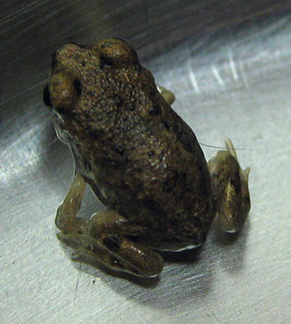|
This photograph of a newly developed spadefoot was taken by Jennifer Williams. Desert Duets: Couch's Spadefoot Info Web Page Information about Spadefoots Although spadefoots are commonly referred to as “toads,” spadefoots have smoother skin than “true” toads and teeth where most toads have none. When fully developed, spadefoots are two and a quarter to three and a half inches long. They have greenish or yellowish netlike markings on a dark brown or black background. Unlike many animals in nature, the females are more brightly colored than the males. When the summer rains come to the Sonoran Desert, people hear the males bleating like goats. Their call is quite loud. According to scientists, a female toad selects the healthiest mate based on the deepness and loudness of the male's call. To hear the Couch's spadefoot's call, use the links on the resources page. Spadefoot Pages: Home | Information | Babies | Activity | Resources |
